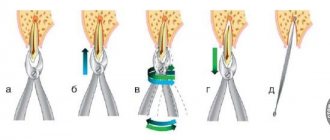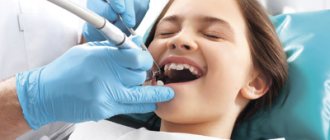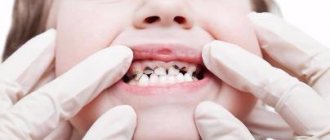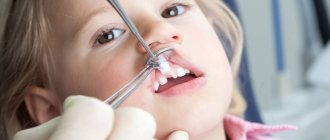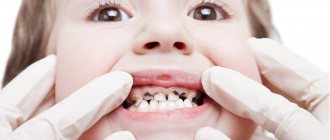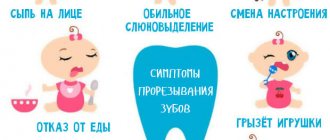Tooth extraction is one of the oldest procedures in dentistry. If previously it was practically impossible to pull out a tooth without blood and pain, today dental offices have all the necessary medications and instruments to make this procedure quick and painless for both children and adults.
You can pull out a tooth both in the clinic and at home, but it is important to understand that the procedure involves surgical intervention and is risky for those who do not have special knowledge. There are many indications for tooth extraction, but the main one is the replacement of baby teeth or a chronic infection that destroys the root and permanent tooth, and harms the entire oral cavity. Many patients come to us because of pain in the area of their wisdom teeth. In many cases they are also removed.
How to pull out a baby tooth without pain
A baby is born without teeth because he does not need to chew food - breast milk or formula passes easily into the stomach.
At four to five months, the first milk teeth appear, which gradually fall out at five to seven years, being replaced by permanent teeth. You don’t have to go to the dentist to pull out a loose tooth—you can do it at home in a variety of ways. Before the procedure, it is important to make sure that the milk jug is ready for removal and that the child has no contraindications. Also, do not forget about cleaning the oral cavity after the procedure.
Loose teeth - reasons
The main provoking factors of pathological mobility of dental units can be:
- Inflammatory and non-inflammatory gum diseases - gingivitis, periodontitis, periodontal disease. One of the most common causes of mobility.
- Chronic diseases: psoriasis, diabetes, thyroid dysfunction, some types of metabolic disorders, arthritis, osteoporosis.
- Disturbances in the functioning of the immune system.
- Bite pathologies.
- Hereditary predisposition.
- Hypovitaminosis and hormonal changes.
- Taking certain medications.
- Advanced root caries and other types of “dental” diseases (periodontitis, cyst, granuloma, etc.).
- Injuries, bruxism, unhealthy diet, bad habits.
In addition, in cases where the front teeth are loose, we can talk about non-compliance with hygiene standards - in the absence of proper care, hard plaque accumulates in the root part of the teeth, which gradually provokes inflammation of the gums and disruption of the dentogingival bonds.
If you have a problem similar to that described in this article, be sure to contact our specialists. Don't diagnose yourself!
Why you should call us now:
- We will answer all your questions in 3 minutes
- Free consultation
- The average work experience of doctors is 12 years
- Convenient location of clinics
Single contact phone number: +7
Make an appointment
Having noticed the high mobility of their own dental units, many people are interested: if a tooth is loose, can it be saved? It all depends on the cause of mobility, the degree of oral health and the general condition of the body. In any case, timely visit to the dentist significantly increases the chances of preventing edentia.
When can you pull out a child’s baby tooth at home?
Changing teeth is a natural and necessary process of development of the maxillofacial apparatus. The peculiarity of the structure of milk jugs is that they have short nerve roots, which makes their loss painless. In most cases, changing milk jugs occurs independently and does not require outside intervention. It is possible to remove a temporary tooth in cases where it is well loosened, but at the same time it interferes with speaking and chewing. In such situations, it is permissible to carry out the manipulation at home without visiting a doctor.
How to understand that you can pull out a child’s baby tooth:
- there is no pain or blood when the milkman staggers;
- healthy pink gums;
- the tooth moves easily back and forth in the hole;
- no stomatitis, gingivitis, tonsillitis;
- The child feels well and is healthy.
Why is it dangerous to leave a tooth root in the gum?
- The inflammatory process in it has not stopped, the danger of inflammation of the jaw tissue increases;
- Caries can spread to neighboring teeth;
- ENT diseases may develop.
The root of the damaged tooth must be removed. This is a complex procedure that requires the use of antibacterial drugs and anesthesia. It should be performed by an experienced doctor.
Removing tooth roots on your own is dangerous, as it is difficult to remove them completely. In addition, there is a high risk of infection of the hole.
You can solve this problem yourself only under certain conditions:
- The damaged tooth is very loose;
- It’s impossible to get to the dentist’s office, and the tooth hurts unbearably.
What risks exist:
- Inflammation may develop;
- The root can only be partially removed;
- Possible heavy bleeding.
Do not use the door handle for removal. Safe removal is possible only after systematic loosening.
To do this with minimal risk of tissue damage and infection, you need to follow a number of recommendations.
- Assess the situation - whether you can cope with the task. If the tooth is tightly fixed, is it worth starting extraction? A tooth that is tightly held cannot be removed.
- A loose tooth should be further loosened with the tongue. Perhaps it will fall out on its own.
- Before attempting to extract the root, wash the flour, brush your teeth with toothpaste, and rinse your mouth with a disinfectant (rinse) to ensure maximum disinfection. You can use special solutions. It is important that they contain alcohol.
- Use of painkillers. The painkiller should not cause side effects. For the drug to take effect, you must wait at least half an hour.
Contraindications to tooth extraction at home
Before choosing a method to extract a tooth yourself, it is important to make sure that this manipulation will not cause harm. The presence of the following manifestations is a contraindication for removing thrush at home:
- redness of the gums;
- strong adhesion of the tooth to the jaw;
- thickening of the gums due to swelling;
- the presence of blood or pain when the milkman staggers;
- increased body temperature, signs of acute respiratory viral infection, sore throat;
- the child has severe fear.
When performing a manipulation, you cannot hold the child by force, otherwise the fear of performing procedures in the mouth will remain for life. In all doubtful and complex cases, you should contact a specialized specialist - a pediatric dentist.
Children often experience carious lesions in primary teeth, leading to their partial destruction. Such situations require a mandatory visit to a doctor with subsequent treatment or removal. Even severely damaged carious teeth cannot be pulled out on your own - this will lead to pain and injury to the gums and lips.
“A new tooth is shaking” is really not always a reason to panic
During the period of change of bite, which starts at the age of 5–6 years, children's baby teeth begin to loosen. Following this, permanent ones appear who will have to faithfully serve the matured child throughout his life. The process of eruption of molars has its own characteristics.
- First, the dental crown appears, and the root that holds it in the jaw bone remains incompletely formed at this point.
- Therefore, for some time (usually no more than a year), a molar that is not firmly fixed can actually wobble slightly, and then it will strengthen naturally.
By the way, it is useful for adult dental patients to know that normally all permanent teeth have so-called physiological mobility. Our teeth are fixed in the bone alveolus with the help of a ligamentous apparatus, periodontium. Periodontal tissues perform shock-absorbing functions, evenly distributing the mechanical chewing load over the entire dentition and preventing the destruction of individual teeth under the influence of fairly serious chewing pressure. Few non-specialists know that with the help of the chewing muscles, our jaws can develop a force of up to 300–400 kg, depending on the consistency of the chewed products.
But if a mother notices that a child of 8–10 years old has a permanent tooth loose, the mobility is pronounced and accompanied by pain, the gums are swollen, and the child is also capricious and refuses to eat, it is necessary to urgently go for a consultation to pediatric dentistry. It is better to play it safe and exclude pathological mobility in order to prevent the possibility of premature loss of a tooth.
Preparing a child for tooth extraction
Before pulling out a child’s tooth, it is important to carry out psychological preparation - explain in a calm voice the essence of the procedure and its purpose, emphasizing that it is not painful and quick. You can come up with a fairytale story about the milkman's journey or tell that mom and dad also had their temporary teeth pulled out.
You also need to ask the child to swing the tooth as much as possible with his tongue - this will make it possible to quickly pull it out of the gums. When the milkman wobbles, its short nerve endings are torn off or pulled out of the canals, so there is no pain syndrome.
Wisdom teeth extraction
You can remove a wisdom tooth if you can loosen it and grab it tightly with your fingers. Place a cotton swab in front of the cheek on the area of the problem tooth. These teeth have long roots, making it almost impossible to remove them yourself. Tooth extraction requires a careful approach, but it is equally important to avoid future infection.
For this:
- Provide the empty hole with maximum peace;
- Brush your teeth, but be careful not to wash away the clot that has formed;
- To improve blood circulation in the injured area, apply warm, damp compresses to the gums;
- Rinse your mouth after every meal;
- Stick to a diet - hot and cold foods should be excluded;
- Use painkillers only when absolutely necessary, avoiding overdose.
Carrying out the procedure, simple tips
On the Internet you can find a lot of advice on removing temporary teeth, containing both descriptions of traditional methods and absurd proposals using improvised means. It is always important to think about the safety of the action for the child’s health and the possible consequences; it is better to give preference to one of the following two methods:
- use fingers and a handkerchief;
- apply thread.
Regardless of which manipulation it is decided to remove the milk duct, both participants in the procedure need preliminary preparation aimed at preventing infection. Before pulling out a baby tooth, an adult should thoroughly wash their hands with soap, and a child should rinse their mouth with warm water.
You can remove the milk jug like this: take a clean cloth, grab it and sharply pull it up if the tooth grows from the lower jaw or down if it grows from the upper jaw. This manipulation usually scares children, so they often resort to a more popular method. How to pull out a child's baby tooth using floss:
- Position the light source so that the oral cavity is well illuminated.
- Take a nylon thread about 30 cm long; tie one end to the loose tooth, making 4–5 turns around it; wrap the other around the index and middle fingers of an adult.
- Make a sharp movement with your hand, jerking your hand down if the milk duct grows on the upper jaw or upward for cases where the tooth is on the lower jaw.
Tooth extraction, if all conditions are met, takes no more than 5 minutes and is not accompanied by pain or other unpleasant sensations. Correctly performed manipulation does not leave the child afraid of the dentist and manipulations in the oral cavity.
Tips on how to pull out a tooth yourself correctly:
- position the thread so that it does not touch the lip, otherwise there is a risk of injury;
- do not use improvised means and tools;
- make sure the milk jug is ready to be removed.
If the tooth is well loosened, but the child is afraid to remove it with floss or fingers, and does not want to go to the doctor, you can give it an apple to chew on - solid food will cause the duct to fall out quickly and without pain.
What not to do for tooth loss
When a child complains of a loose tooth, parents should not use methods to remove it, based on funny videos from the Internet:
- Do not tie one end of the string to a tooth and the other to a door handle, bicycle, or anything else. This method will not work if the tooth is firmly seated, but will only bring pain and psychological trauma to the child. There is also a high probability of removing only part of the tooth, without the root;
- tweezers, clamps, rope, pliers and other tools are also not suitable for the procedure, since carelessness can injure and frighten the child;
- moving the tooth left and right - this injures the gums, causing bleeding and causing discomfort to the child.
Have you ever helped your child loosen a tooth? Or does he do it on his own? Share interesting stories in the comments.
Main photo: 1000sovetov.ru.
Oral hygiene after tooth extraction
Immediately after you have pulled out the tooth, you need to moisten a cotton ball with chlorhexidine and place it in the hole for 10 minutes. If a small amount of blood appears, then use hydrogen peroxide for these purposes - it not only disinfects, but also helps stop minor bleeding.
To form a full-fledged blood clot, as well as to prevent food particles from getting into the wound and causing infection, after the manipulation the child is not allowed to eat or drink for 2 hours. Please note that alcohol and vodka are not used to treat wounds in children.
Further care after baby tooth extraction:
- On the first day, brush your teeth without touching the socket with the brush. You should not use a paste - its components will irritate the wound surface.
- Rinse your mouth with chamomile decoction and a weak soda solution 4-5 times a day for 5-7 days. It is imperative to carry out this procedure after eating to remove food debris - otherwise an inflammatory process may develop.
- Eliminate salty, spicy and hard foods from the diet for 5 days. These products have an aggressive effect on the mucous membrane and can cause bleeding from the socket and pain.
- In children with frequent inflammatory diseases of the oral cavity, a warm antiseptic solution of furatsilin can be used for rinsing.
Author: Zhukov M.A.
With complete absence of a tooth
Prosthetics for front teeth in the absence of them involves 2 main methods:
- Installation of a bridge prosthesis
- this method is suitable for replacing 1 to 4 missing incisors. A bridge is a structure of several connected crowns, 1-2 suspended in the center and 2 hollow on the sides, which are attached to adjacent supporting teeth. The main disadvantage of the method is the need to grind and often depulpate the supporting units, even if they are completely healthy. That is, if you need to restore 1 missing incisor, two adjacent ones will have to be injured. - Implant prosthetics
– technology allows you to restore any number of missing teeth in a row. An implant is implanted into the jawbone, which fully replaces the missing tooth root. After the implant has healed, an adapter (abutment) is installed on it, onto which an artificial crown is fixed, identical in shape and color to the natural tooth. If an entire segment of the dentition is missing (3 or more teeth), 2 artificial roots are implanted, onto which a bridge is fixed. - Prosthetics of the front tooth immediately after extraction
is performed using the express implantation method. Immediately after surgical removal of a tooth, an implant is screwed into its socket, an abutment and a temporary crown made of lightweight plastic are fixed onto it. The temporary crown is removed from the bite, does not take part in chewing, it is necessary only to preserve the aesthetics of the smile. After 2-3 months, when the implant has fused with the bone, the temporary prosthesis will be replaced with a permanent one made of durable, reliable material (metal-ceramics, zirconium, etc.).
Prosthetics on implants does not involve injury to neighboring units; implanted implants perform all the functions of a natural tooth root and prevent jawbone atrophy. Implants are implanted once and for all; only prosthetic structures are subject to replacement (if they break or end their service life).
